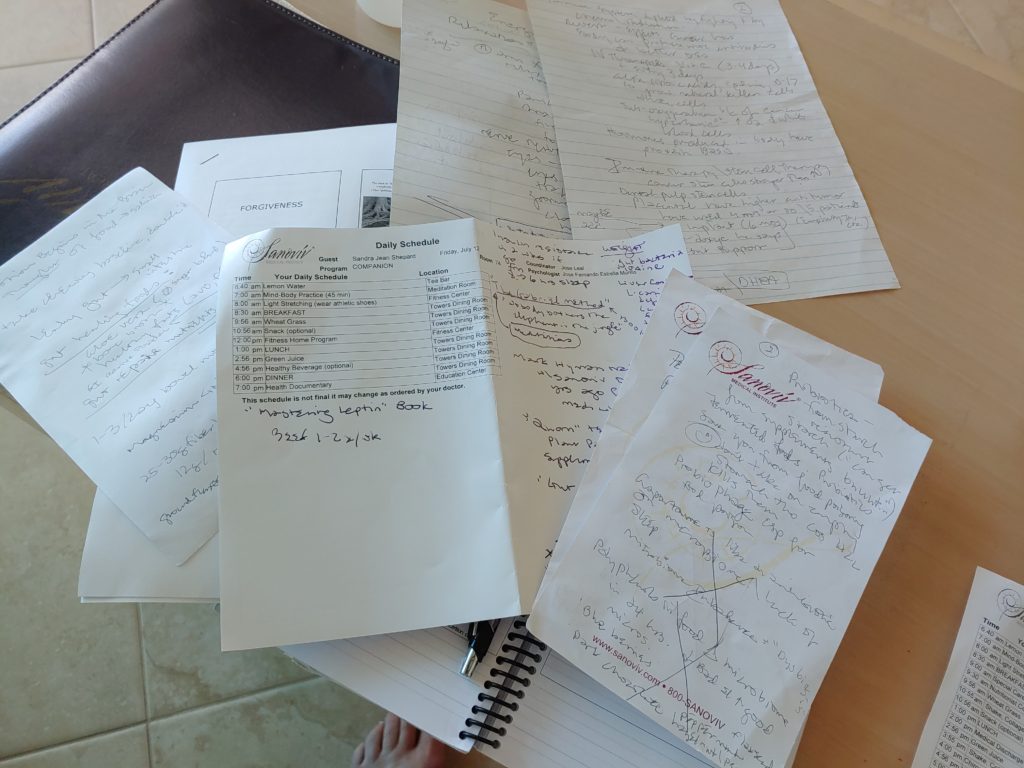
This post is – quite literally – just a compilation of all the notes I’ve written that didn’t already “wend their way” into another post! I guess I will do them as “bullets” – but there’s no rhyme or reason to what goes first, next, etc. Just notes :-)

- Energy Medicine Brain Hack (Anxiety/Sleep): Parasympathic = relaxation = healing and repair. One way to address this (as well as sleep issues, worry, anxiety) is to cross your left foot over your right, then your right arm across your left. If you can do it, put your right arm across your left, grab your palms/interlace your fingers, then turn your hands “in and up” so that you are in “prayer” pose with your fingers intertwined and your wrists crossed. Relax and release your tongue to the bottom of your mouth. Breathe deeply for about a minute. (Pretty sure I have mentioned this before, but I don’t have it “crossed off” my notes, so…)
- Energy Medicine Brain Hack (Anxiety): Another way to deal with panic, anxiety, and feeling “out of body” is to put your finger out in front of your face (arm straight), focus on that finger for 5 seconds, then focus on something far beyond it for 5 seconds – do this for about 1/2 dozen times. If you’re in a public situation, you can just focus on something “at about arm’s length” and then take a “long” view. You are engaging the nerve endings behind the eyes and sending a message to the brain. The eyes are very important in tracking danger, so if you’re telling your brain that you’re not “concentrating” on looking for something to attack you (long distance) or something fighting you (short distance), it works as a brain hack that there is no danger.
- Breathing in enhances the Sympathetic system. This is your “fight or flight” system. Breathing out enhances the Parasympathetic system, which is “calm down, relax, it’s all okay.” In remembering my “off the charts” Sympathetic energy response vis-a-vis the Parasympathetic, my psychologist discussed breathing out for a longer time than breathing in. Concentrating on the “out.”
- “Hobnob” is an app (both iPhone and Android) that helps coordinate in-person gatherings. It’s “fremium” – if you use it a lot, you’ll need to pay. It’s like Evite on steroids/text (v. email)-based. Has designed invitations, a method for planning events, video-based invites, etc. The invites are sent via text, which allows instant RSVPs without guests having to download the app. There is a “private forum” feature for event-based conversations, and they are adding a feature to pay for events. Hobnob prioritizes in-person connections and cultivates relationships – started by a Hawaiian – over 10 million invitations have been sent, it takes about 30 seconds to create an invite from one of their templates (though you can upload your own), 6+ million individual people have been invited to a “Hobnob party” so far, and it costs $0 to create 10 invitations per month.
- Iodine levels test as low (might have already noted this somewhere else). As a way to deal, nori/ “sea green leafies” are a great source, be sure that they are from a clean source. Also using iodized salt (e.g., standard “Morton salt” versus the “fancier” salts) can help. Either use it in cooking, or use it on the table, one or the other. Using a sea salt or “full spectrum” salt is good for the other minerals, but I test low in iodine. Affects thyroid function, so this might be a reason that thyroid has been affected.
- Cancer invades the vascular system and produces an oxidative stress. It particularly affects the lungs and liver, even if “lung cancer” and “liver cancer” aren’t tested as “being present.” As such, there is less oxygen in the body, which means that there will be less absorption of food, etc. (Body needs to “make a fire” to burn/get the energy out of food, and fire needs O2.) Cancer makes its own blood vessels to block (“catch”) antibodies that the body makes to fight it. Cancer also “eats” sugar, and then grabs insulin before cells can get to it. So this means that sugar is left out in your blood stream, which is hugely stressful on the body, because the cancer ate the insulin that was trying to attach to it (leading your body into a diabetic state of affairs). However, keto diet, which is being touted these days, is very difficult on the body and also most people don’t really get into ketogenesis using it – the stress helps empower the cancer. (More on diets/food in a separate blog post.)
- The immune system is depleted by just the “idea of” fighting cancer, and also by chemo and radiation. After these happen, you need to revert your body to “Healthy” – in other words, reverse the effects the cancer has had. Concentrating on “fighting” cancer is just more stress. If possible, try to “love” the cancer, for showing you issues in your life that perhaps were not as they should have been/where you weren’t paying attention. The body can produce far more antibodies and better antibodies at that, if it doesn’t have to “worry about you” “fighting” something.
- All hormones produced by the body have a protein basis; as such, you need enough quality protein to make enough hormones. Often this is not obtainable on a vegan diet. It’s hard to “feel” that you aren’t producing enough hormones until it becomes critical. By not having enough quality protein, you literally cannot build hormones – you “starve” your system of the ability to build them.
- Pancreatic enzymes are needed to “eat” animal protein. By having your daily animal protein at Breakfast and Lunch but none at Dinner, this gives your body a head start for your fast between Dinner and Breakfast, and those enzymes can work on your blood, cleansing and cleaning it. Since the vegetarian diet lacks the substrate (protein building blocks) for pancreative elastase-1 as an enzyme, this will decrease secretion of this enzyme, which can lead to malabsorption of food/minerals/vitamins. New drugs deal with “pancreatic insufficiency” (of course they do . . . ) but in reality the first defense is to get your diet on track.
- An alkaline-forming diet (which is terrible for cancer) is less than 25% animal protein (but contains animal protein), plus fruits and veggies.
- The First Aid Stress Tool (F.A.S.T.) can be utilized as an at-home way to give extra support after an N.E.T. office visit. The NET procedure addresses the mind/body effects of stress, helping deal with the root causes. Recurring stress patterns are often because the subconscious reminds us in current situations of old traumatic events (Conditional Response). NET and FAST focus on eliminating the conditioned response. With FAST, you touch the acupuncture points for stress (located on the forehead) and some of the pulse points that represent organ meridians, thus covering many of the normal emotional responses to stress. The idea is to touch these points and think about the stressful circumstance and embody the uncomfortable situation (where do you feel it?) After a few deep breaths, the “charge” will lessen. FAST is not a replacement for NET work with a licensed psychologist, diagnosis, or treatment, it is for home support. There are homeopathic tinctures that are also compatible with supporting this work. Kids particularly can use FAST in high stress situations after being walked through it with a child psychologist that practices NET.
- Forgiveness lecture: Forgiveness is taking your power back – it’s all about you. It’s about improving your mental health and healing yourself, not about the people that hurt you. It’s 100% inwardly focused. It is not about condoning unkindness, denying or minimizing the hurt, forgetting that something painful happened, giving up feelings, excusing poor behavior. Forgiveness is not the same as “reconciliation,” and it does not have to be an “otherworldly” or “religious” experience. “Forgiveness is the feeling of inner peace that emerges as you take your hurt less personally” (Dr. Fred Luskin, “Forgive for Good” and co-founder of the Stanford University Forgiveness Project – the largest scientific study on forgiveness ever). Creating a “Grievance Story” = “Renting too much space to disappointment.” Difficult situations that we are still returning to in our mind gives away our power and keeps us in the past. Blaming the offender of a past offense for how we feel about it gives away that power and “adds insult to injury.” You are insulting yourself as you continue to blame an offender for how you feel. Think about being the “Hero” not the “Victim” – better yet, get out of the “Victim Triangle” altogether. (N.B.: I did a podcast on this a long time ago.) Do you want to be “right” or do you want to be happy/at peace? Free your mind. There are 3 preconditions for forgiveness: (1) know what your feelings are about what happened (do you still feel anger? ashamed? embarrassed? What is it, specifically?). (2) be clear about the action that wronged you (what, very specifically, happened? Look at it as if it was a movie – without any emotion – just watch it. Imagine the motivations, and particularly know that the motivation of the “other party” in the situation is 99.9% not to cause the feeling that you are still carrying around with you). (3) share your experience with at least one or two trusted people that aren’t in any way involved. Don’t rush forgiveness. (Books: “Forgive for Good,” Fred Luskin, “Taming Your Gremlin,” Rick Carlson, “Loving What Is,” Byron Katie, “Man’s Search For Meaning,” Victor Frankl)
Forgiveness is releasing all hopes for a better past.
Fred Luskin

I like these — thanks!
@Susan : Nutrition ones coming up next ;-)